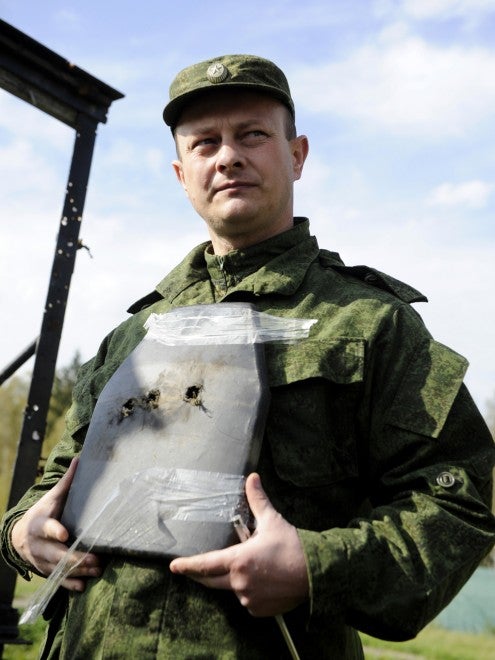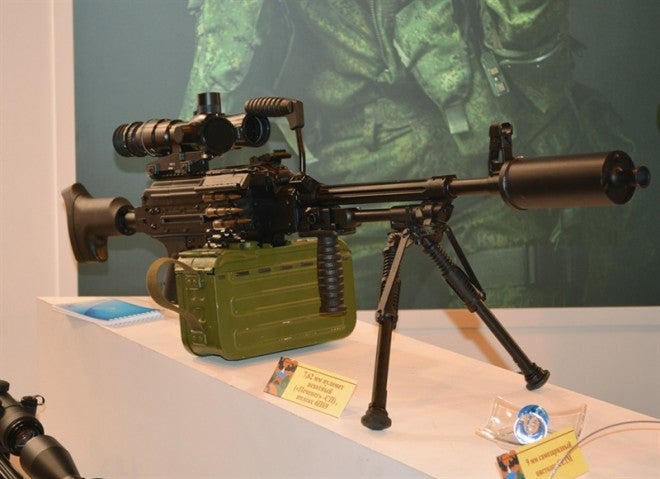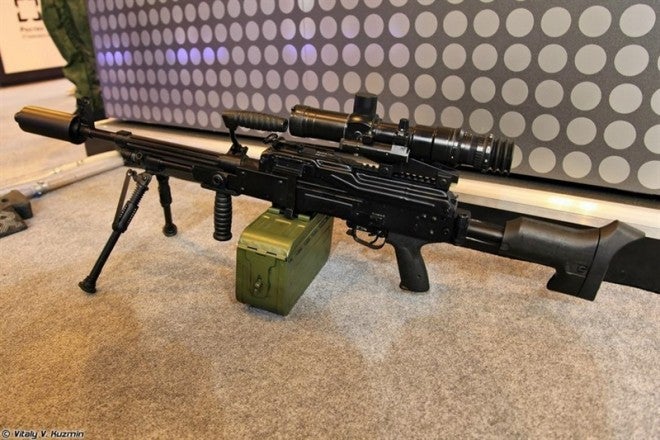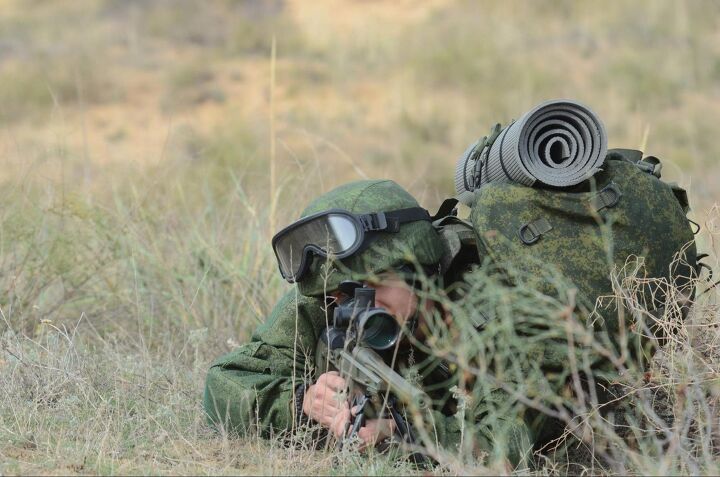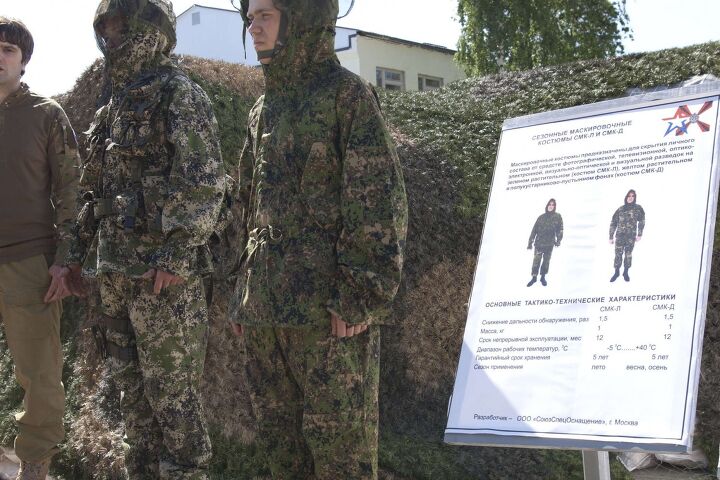Russia’s next-generation infantry modernization program is in full swing, and while here at TFB we’ve covered two of the rifles, the AEK-571/A545 and AK-12, competing for orders as part of the program, but the program as a whole is more extensive than just a new infantry weapon. The project, called Ratnik (a Russian word equivalent to “warrior”) is a total modernization of infantry equipment, introducing over 40 new items, including camouflage, comms gear, sights, body armor, navigation equipment, designators, and, of course, small arms. A three-year order for Ratnik equipment was placed in October of last year, and is expected to consist of deliveries of 50,000 units per year.

Russian soldier in Ratnik gear with an AK-12 rifle, running. Note the Aimpoint red dot optic, or something very similar. Image source: rbcdaily.ru
Russian experts predict a 20% increase in the effectiveness of infantry small arms, and a 24-34 kilogram reduction in weight for Ratnik gear, compared to legacy kit. Ratnik body armor, such as the Tekhikom 6B45 ballistic vest and plate carrier, reportedly raises the rating according to the Russian GOST R standards from 3 for previous body armor to 6, giving protection against the SVD marksman’s rifle firing 7N13 hardened armor penetrating ammunition (roughly equivalent to US .30-06 M2 AP).

6B45 vest, a part of the Ratnik gear. The vest also displays a digital camouflage pattern, which appears to be the Russian EMR pattern or a variant. A plate can be seen behind the bust to the left. Image source: wikipedia.org
In addition to the AK-12, Ratnik will also introduce new variants of the Pecheneg light machine gun, and the SVD marksman’s rifle, both now with adjustable folding stocks and new Picatinny-type sight rails.
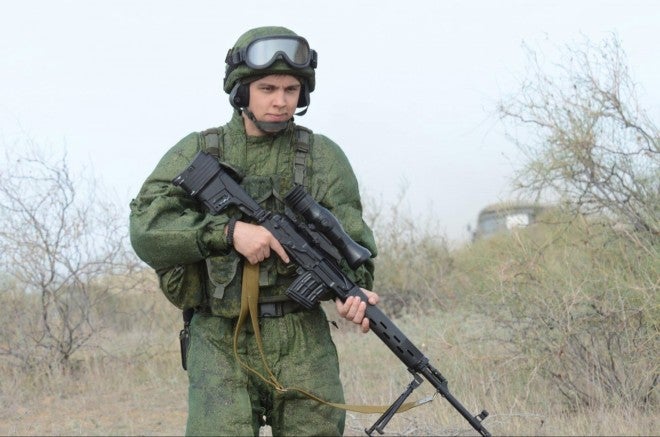
The new modernized Dragunov rifle, as part of Ratnik. The stock is adjustable, and folds, and the receiver cover comes equipped with a Picatinny-type rail mount. The optic is a new thermal scope. The soldier is wearing the new 6B34 goggles, developed for Ratnik. Image source: topwar.ru
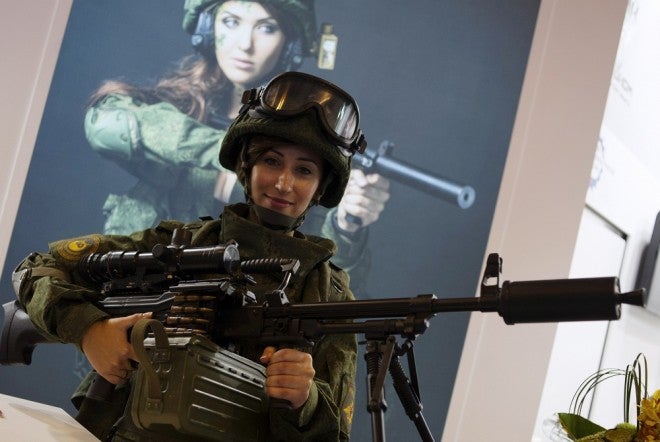
A Russian woman in Ratnik gear at an expo. She holds one of the new variants of the PKM machine gun, produced for the Ratnik program, featuring a new bipod, optic, suppressor and flash hider, and an adjustable folding stock.
The very expensive (380,000 rubles, equivalent to over $12,000 per unit with pre-Crimea exchange rates) Orsis T-5000 sniper rifle has also been displayed alongside Ratnik gear; it is a very modern chassis-based sniper rifle, and reportedly very accurate:
Ratnik is not just introducing body armor and small arms, however, but also smaller items, like a universal multitool/knife made by Milita, and a submersible watch made by Vostok-Design. The new 6B47 helmet is made of composite materials and very lightweight, at only 1 kilogram (the US ACH starts at 1.36 kg).

The 6B47 Ratnik helmet, weighing 1,242 grams fully loaded. The ACH in loaded configuration is 1.63 kg. Image source: rbcdaily.ru
A further focus of the program is networked comms gear, allowing for better integration with electronics systems, and better communication within the organization of the Russian Army. This gear, perhaps somewhat optimistically, is expected to improve the infantry’s effectiveness by 1.5-2 times.

A dummy wearing some of the comms equipment developed for Ratnik. A radio handset and personal computer are visible. While this does not resemble Strelets sets I’ve seen previously, it may be a variant or improved version. Image source: rbcdaily.ru
The Russian army is also introducing new “all-purpose” uniforms, called VKPO. This picture-heavy article by Denis Mokrushin goes into exhaustive detail about the VKPO uniform, for those interested. The Ratnik program will also introduce new camouflage pattern smocks, shown below:
The equipment expected to be fielded with the Ratnik program has not yet reached service, but field tests began in May of this year. Paratroops who evaluated the new equipment are reportedly very happy with the new weapons, and vests, but there is some dissatisfaction with the optics, helmets, backpacks, and the user interfaces and software of the electronics (a common problem for military digital systems). Regarding the backpacks, below is a translated segment from the VZ.ru article linked above:
We were given two backpacks: the so-called “Raid” backpack (V-50 liters) and 10 liters – “Assault” backpack. If the “Assault” is very comfortable, thanks to good straps, “Raid” is very uncomfortable. Incidentally, inside of assault backpack there is armor plate inserted. It is not clear why they put in there, but if they are pulled out, the backpack loses its shape and becomes a bag.
(…)
Sleeping bag is too cold and again cumbersome. And the funny thing – it is difficult to fit into the compartment on the raid backpack designed specifically for it.
Some elements of Ratnik have already been adopted by the Russian Army, but fielding of most systems is not expected to begin until next year at the earliest. Reportedly, the Ratnik system has already been fielded with Siberian Army Special Forces units, though how much of the equipment they have received is unclear.
Finally, the Russians are looking ahead to Ratnik-2, a program expected to equip the Russian Army for the late 2030s. That program seeks fairly ambitious advancements in low visibility in the IR and thermal spectrums, as well as color-changing camouflage, and a power supply in the soldier’s vest.
Thanks to Retiv for his help with this article.
 Your Privacy Choices
Your Privacy Choices

